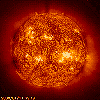Paris (AFP) August 9, 2000 - Two European satellites were launched Wednesday on the final phase of a two-year mission to monitor the Earth's magnetic field, space officials here said.
The two spacecraft, named Rumba and Tango, were taken aloft at 1213 GMT aboard a Russian-built Soyuz rocket from the Baikonur space centre in Kazakhstan, the European Space Agency (ESA) told AFP.
Rumba and Tanga were to be placed in orbit after a flight of approximately 90 minutes.
They will later team up with two identical satellites, Samba and Salsa, which were launched on July 16.
The four will then fly in tetrahedral formation -- a shape like a pyramid with a triangular base -- in an egg-shaped orbit, ranging from 119,000 kilometers (74,000 miles) at its farthest point from the Earth to 19,000 kms (11,800 miles) at its closest.
The so-called Cluster mission will measure the magnetic field that invisibly cloaks the Earth and protects it from the solar wind, the buffeting flow of electrically-charged particles spewed out by the Sun.
Electrical currents generated by magnetosphere also cause the famous northern and southern lights at the Earth's poles.
The ESA is a 25-year-old consortium gathering 14 European countries. The launch was carried out by STARSEM, a Franco-Russian joint venture that markets Soyuz launches.
ESA Cluster II
ESA Space Weather site
Starsem
Cluster Instrument Sites
Imperial College, London (Fluxgate Magnetometer)
Mullard Space Science Laboratory (Plasma Electron and Current Experiment)
Rutherford Appleton Laboratory (Cluster Joint Science Operations Centre)

 Eleven Year Solar Cycle Peaks
Eleven Year Solar Cycle Peaks